Conchita Montenegro (1911-2007) was a sultry Spanish model, dancer, and stage and screen actress. She starred in several Spanish productions, but also in French, German and American films.
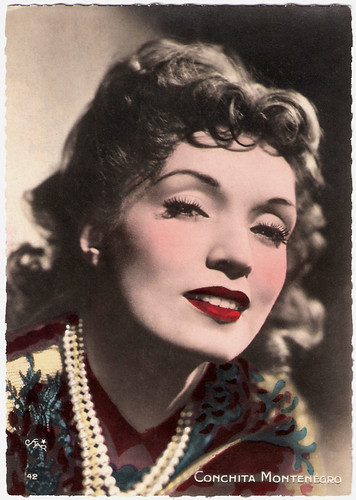
French postcard by Editions P.I., no. 42. Photo: Star.
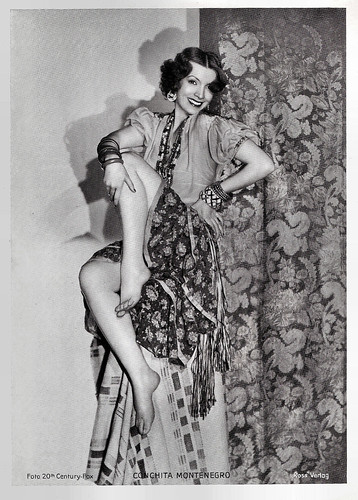
Big German card by Ross Verlag. Photo: 20th Century Fox.
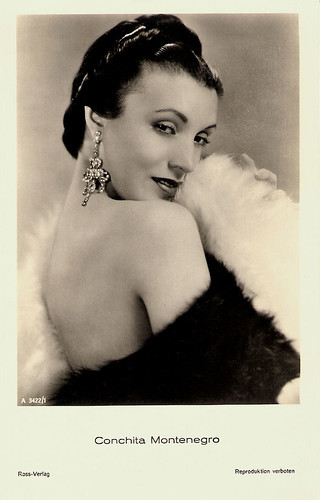
German postcard by Ross Verlag, no. A 3422/1, 1941-1944.
Conchita Montenegro was born Concepción Andrés Picado in San Sebastian (Basque country) in 1911. She left her home town at the age of ten, moving to Madrid, where she was educated in a convent.
Conchita first worked as a model for the painter Ignacio Zuloaga y Zabaleta, and learned classical and Spanish dance. In her adolescence she went to Paris to follow dancing and acting lessons at the Opera school.
At her return in Spain she formed a dancing duo with her sister Juanita as Las Dresnas de Montenegro, to great acclaim in the capitals of Europe. She also toured with the Fanchon & Marco dance troupe. Montenegro supposedly revolutionised Spanish dance.
Her sensuality and beauty (brown eyes, wavy black hair, and an olive complexion) were soon discovered by the cinema world. In 1927, she did her first Spanish film La muñeca rota (Reinhardt Blotner, 1927), followed by Rosa de Madrid (Eusebio Fernández Ardavín, 1927) and Sortilegio (Agustín de Figueroa, 1927).
In 1928 Conchita Montenegro starred in the French film La Femme et le Pantin / The Woman and the Puppet (Jacques de Baroncelli, 1929), the second of eight film adaptations of Pierre Louÿs’ classic novel about a Spanish femme fatale. In his review at IMDb, Mario Gauci notes that Montenegro "has the requisite spunk and sensuous charge for the role".
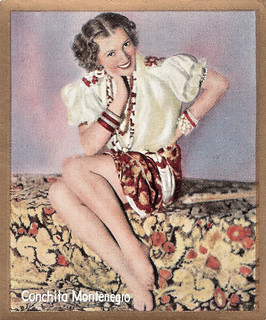
German cigarette card in the series 'Unsere Bunten Filmbilder' by Ross Verlag for Cigarettenfabrik Josetti, Berlin, no. 128. Photo: Fox.
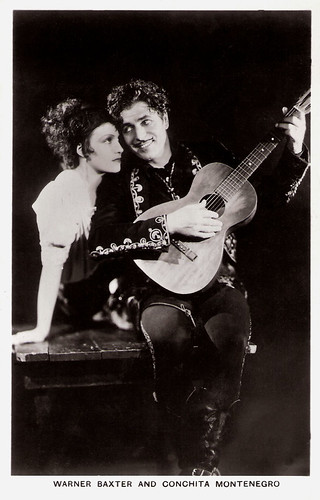
British postcard in the Film Partners Series, London, no. P 4. Photo: publicity still for The Cisco Kid (Irving Cummings, 1931) with Warner Baxter.
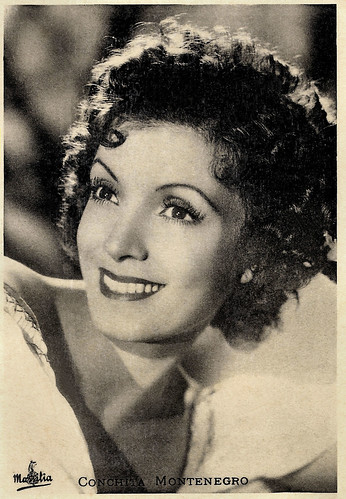
French collector card by Massilia.
In the summer of 1930, Conchita Montenegro went to the US when MGM offered her a contract. She was seventeen years old and could not speak English. Dubbing was not yet standard practice, so she was cast in several Spanish versions of MGM films, destined for Spain and Latin-America. These included De frente, marchen! / Doughboys (Salvador de Alberich, Edward Sedgwick, 1930) with Buster Keaton, Sevilla de mis amores / The Call of the Flesh (1930) by and with Ramón Novarro, Su última noche (Carlos F. Borcosque, Chester M. Franklin, 1931) with Ernesto Vilches and Juan de Landa, En cada puerto un amor / Way for a Sailor (Carlos F. Borcosque, Marcel Silver, 1931) with José Crespo and again De Landa.
She quickly learned English and then played in English spoken films: the romantic comedy-drama Never The Twain Shall Meet (W.S. Van Dyke, 1931) starring Leslie Howard, and Strangers May Kiss (George Fitzmaurice, 1931) with Norma Shearer and Robert Montgomery. One anecdote from her Hollywood times goes that when during probing she refused to kiss Clark Gable, long-standing film expert Lionel Barrymore remarked: "That little girl [she was 18] will give us much playtime".
By mid-1931, Montenegro had left MGM and signed with Fox, where she stayed until 1935. Hans J. Wollstein at AllMovie: "Fox (...) made her a 'Fox Debutante' in 1931 along with Helen Mack and Linda Watkins. Unlike Mack and Watkins, however, the studio never really pushed Montenegro, who instead labored in stock assignments." In August 1931 she was nearly killed in a train crash near Yuma, Arizona, while en route with Warner Baxter and Edmund Lowe to shoot The Cisco Kid (1931) in Tucson.
At Fox, Montenegro acted in various Spanish versions of Hollywood films: Hay que casar al príncipe (Lewis Seiler, 1931), Marido y mujer (Bert E. Sebell, 1932), Dos noches (1933) by Carlos Borcosque, La melodía prohibida (Frank Strayer, 1933), Granaderos del amor (John Reinhardt, Miguel de Zarraga, 1934) with Brazilian actor Raoul Roulien, and ¡Asegure a su mujer! (Lewis Seiler; supervised by E. Jardiel Poncela, 1935) with Roulien, Antonio Moreno and Mona Maris. Montenegro acted in several English spoken Fox productions: The Cisco Kid (Irving Cummings, 1931), The Gay Caballero (Alfred L. Werker, 1932) with George O'Brien, Handy Andy (David Butler, 1934) with Will Rogers, and Hell in the Heavens (John Blystone, 1934) with Warner Baxter.
She also acted in the Mascot Pictures production Laughing at Life (Ford Beebe, 1933) with Victor McLaglen and, again at Fox, in the French version of the film Caravan: Caravane (1934), both directed by Erik Charell and starring Charles Boyer and Annabella. Montenegro acquired the reputation of a social leader in the Spanish Hollywood film colony, leasing a large house and performing as hostess at many gatherings.
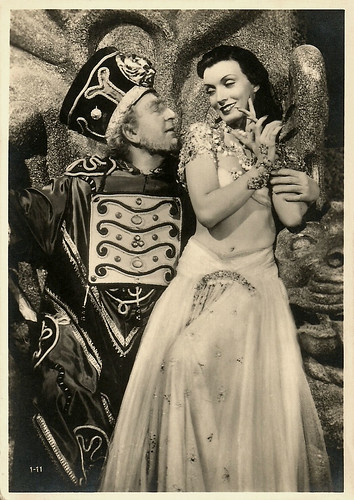
Italian postcard. Armando Falconi and Conchita Montenegro in the Italo-Spanish co-production La nascita di Salomè / The Birth of Salome (1940), directed by Jean Choux, and shot in the Cinecittà studios in Rome.
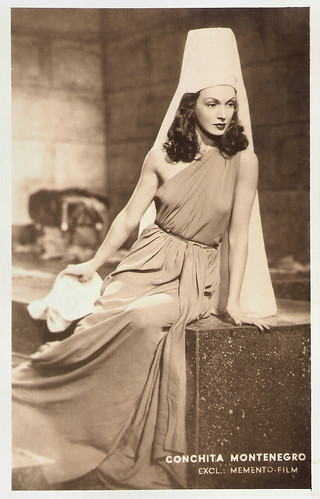
Italian postcard. Photo: Memento-Film. Publicity still for La nascita di Salomè (Jean Choux, 1940).
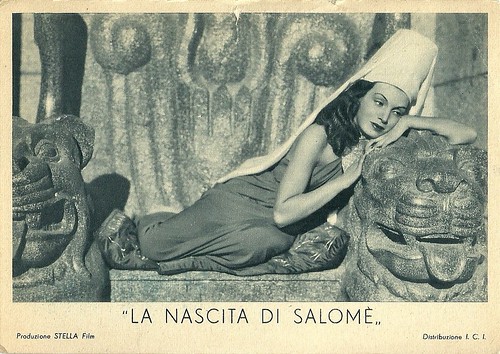
Italian postcard by Prod. Stella Film and Dist. ICI Film. Publicity postcard for La nascita di Salomè (Jean Choux, 1940).
In May 1935, at the peak of her career, Conchita Montenegro’s contract was not extended by Fox. She left for Europe, where she married Raoul Roulien in Paris in September 1935. The couple toured South America and produced a motion picture called Jangada (1936). The film dealt with the customs of primitive people in South America. From 1936 on, Montenegro performed in various European productions, such as the multilingual La vie parisienne / The Parisian Life (1936), shot in Paris by Robert Siodmak, and Lumières de Paris (Richard Pottier, 1938) starring Tino Rossi.
In 1939 Montegro and Roulien went to Argentine where he directed her in the Spanish version of the Brazilian film O Grito da Mocidade (directed by Roulien as well): El grito de la juventud (Raoul Roulien, 1939). Soon after they divorced. In 1940 Montenegro went to France where she acted in L’or du Cristobal (Jean Stelli, Jacques Becker, 1940) with Charles Vanel and Albert Préjean.
Then she moved to Italy where she played in various films: both versions of the multilungual L’uomo del romanzo / Yo soy mi rival /The Man of the Novel (Luis Marquina, 1940) starring Amedeo Nazzari, La nascita di Salomé / The Birth of Salomé (Jean Choux, 1940), and Amore di ussaro (Luis Marquina, 1940). In the historical biopic Melodie eterne / Eternal Melodies(Carmine Gallone, 1940), Gino Cervi starred as the young Wolfgang Amadeus Mozart and Montenegro played his unrequited first love, Aloisa Weber. The heavily fictionalised account of the life of the Austrian composer was shot at Cinecittà in Rome.
The film Giuliano de’Medici (Ladislao Vajda, 1941) offended Benito Mussolini, as it too clearly criticised a dictator. The film was only permitted re-release after cuts and a change in ideology, while Vajda fled to Spain. In 1942 Montenegro moved on to Spain. In Spain she returned as a big film star, after an absence of some 13 years. She played in Rojo y negro (Carlos Arévalo, 1942) with Ismael Merlo, Boda en el infierno (Antonio Román, 1942) with José Nieto, Aventura (Jerónimo Mihura, 1942) with José Isbert, and Ídolos / Idols (Florián Rey, 1943) with Juan Calvo. Ídolos about a French actress who meets a Spanish bullfighter, was made by CIFESA, Spain's largest film studio at the time. Her last film was the historical drama Lola Montes (Antonio Román, 1944) with Luis Prendes. Montenegro played the title role of the legendary Irish-born dancer and courtesan Lola Montez.
In 1944, Montenegro married the Spanish diplomat Ricardo Giménez Arnau, a senior member of the Falangist party and ambassador to the Holy See. She henceforth refused any interviews or honors, so in 1990 she declined the Medal for Artistic Merit by the Ministry of Culture. According to Spanish author José Rey Ximena in his book, 'El Vuolo de Ibis' (The Flight of the Ibis), British actor Leslie Howard – whom Montenegro dated in 1931 after playing together in Never the Twain Shall Meet - used her to get close to Spanish dictator Franco, on instigation of Winston Churchill. Montenegro used her husband's influence to secure a meeting between the British actor and the Spanish dictator while Howard was in Spain on a lecture tour to promote film in May, 1943. Shortly afterwards Leslie Howard lost his life when the civilian plane on which he was a passenger on a return flight to England was shot down by German Luftwaffe and crashed into the Bay of Biscay. "Thanks to him, at least in theory, Spain was persuaded to stay out of the war," Rey Ximena claims of Howard. Having been a widow since 1972, Conchita Montenegro passed away in Madrid in 2007. She was 95.
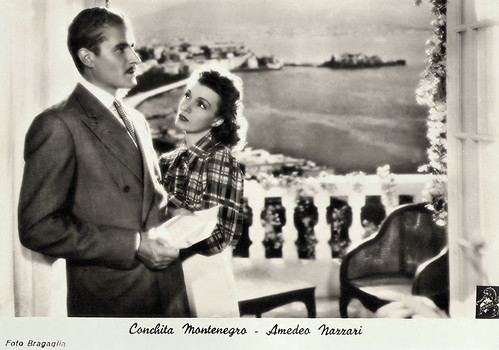
Italian postcard by Alterocca, Terni, no. 6615. Photo: Bragaglia. Publicity still for L'uomo del romanzo / The Man of the Novel (Mario Bonnard, Luis Marquina, 1940). The film is an Italian-Spanish production. The Spanish version is known as Yó soy mi rival (1940). Only Conchita Montenegro, Amedeo Nazzari and Miguel del Castillo appeared in both versions.
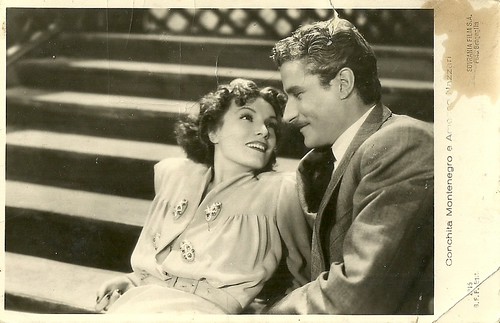
Italian postcard by Ed. Ballerini & Fratini, Firenze, no. 2915. Photo: Bragaglia / Sovrania Film. Conchita Montenegro and Amedeo Nazzari in L'uomo del romanzo / The Man of the Novel (Mario Bonnard, Luis Marquina, 1940).
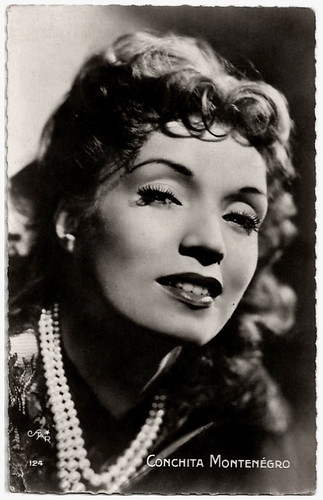
French postcard by Editions P.I., no 124. Photo: Star 124.
Sources: Hans J. Wollstein (AllMovie - Page now defunct), Mario Gauci (IMDb), Wikipedia (English, Spanish and French and IMDb.
This post was last updated on 20 October 2025.

French postcard by Editions P.I., no. 42. Photo: Star.

Big German card by Ross Verlag. Photo: 20th Century Fox.

German postcard by Ross Verlag, no. A 3422/1, 1941-1944.
Sensuality and beauty
Conchita Montenegro was born Concepción Andrés Picado in San Sebastian (Basque country) in 1911. She left her home town at the age of ten, moving to Madrid, where she was educated in a convent.
Conchita first worked as a model for the painter Ignacio Zuloaga y Zabaleta, and learned classical and Spanish dance. In her adolescence she went to Paris to follow dancing and acting lessons at the Opera school.
At her return in Spain she formed a dancing duo with her sister Juanita as Las Dresnas de Montenegro, to great acclaim in the capitals of Europe. She also toured with the Fanchon & Marco dance troupe. Montenegro supposedly revolutionised Spanish dance.
Her sensuality and beauty (brown eyes, wavy black hair, and an olive complexion) were soon discovered by the cinema world. In 1927, she did her first Spanish film La muñeca rota (Reinhardt Blotner, 1927), followed by Rosa de Madrid (Eusebio Fernández Ardavín, 1927) and Sortilegio (Agustín de Figueroa, 1927).
In 1928 Conchita Montenegro starred in the French film La Femme et le Pantin / The Woman and the Puppet (Jacques de Baroncelli, 1929), the second of eight film adaptations of Pierre Louÿs’ classic novel about a Spanish femme fatale. In his review at IMDb, Mario Gauci notes that Montenegro "has the requisite spunk and sensuous charge for the role".

German cigarette card in the series 'Unsere Bunten Filmbilder' by Ross Verlag for Cigarettenfabrik Josetti, Berlin, no. 128. Photo: Fox.

British postcard in the Film Partners Series, London, no. P 4. Photo: publicity still for The Cisco Kid (Irving Cummings, 1931) with Warner Baxter.

French collector card by Massilia.
Not kissing Clark Gable
In the summer of 1930, Conchita Montenegro went to the US when MGM offered her a contract. She was seventeen years old and could not speak English. Dubbing was not yet standard practice, so she was cast in several Spanish versions of MGM films, destined for Spain and Latin-America. These included De frente, marchen! / Doughboys (Salvador de Alberich, Edward Sedgwick, 1930) with Buster Keaton, Sevilla de mis amores / The Call of the Flesh (1930) by and with Ramón Novarro, Su última noche (Carlos F. Borcosque, Chester M. Franklin, 1931) with Ernesto Vilches and Juan de Landa, En cada puerto un amor / Way for a Sailor (Carlos F. Borcosque, Marcel Silver, 1931) with José Crespo and again De Landa.
She quickly learned English and then played in English spoken films: the romantic comedy-drama Never The Twain Shall Meet (W.S. Van Dyke, 1931) starring Leslie Howard, and Strangers May Kiss (George Fitzmaurice, 1931) with Norma Shearer and Robert Montgomery. One anecdote from her Hollywood times goes that when during probing she refused to kiss Clark Gable, long-standing film expert Lionel Barrymore remarked: "That little girl [she was 18] will give us much playtime".
By mid-1931, Montenegro had left MGM and signed with Fox, where she stayed until 1935. Hans J. Wollstein at AllMovie: "Fox (...) made her a 'Fox Debutante' in 1931 along with Helen Mack and Linda Watkins. Unlike Mack and Watkins, however, the studio never really pushed Montenegro, who instead labored in stock assignments." In August 1931 she was nearly killed in a train crash near Yuma, Arizona, while en route with Warner Baxter and Edmund Lowe to shoot The Cisco Kid (1931) in Tucson.
At Fox, Montenegro acted in various Spanish versions of Hollywood films: Hay que casar al príncipe (Lewis Seiler, 1931), Marido y mujer (Bert E. Sebell, 1932), Dos noches (1933) by Carlos Borcosque, La melodía prohibida (Frank Strayer, 1933), Granaderos del amor (John Reinhardt, Miguel de Zarraga, 1934) with Brazilian actor Raoul Roulien, and ¡Asegure a su mujer! (Lewis Seiler; supervised by E. Jardiel Poncela, 1935) with Roulien, Antonio Moreno and Mona Maris. Montenegro acted in several English spoken Fox productions: The Cisco Kid (Irving Cummings, 1931), The Gay Caballero (Alfred L. Werker, 1932) with George O'Brien, Handy Andy (David Butler, 1934) with Will Rogers, and Hell in the Heavens (John Blystone, 1934) with Warner Baxter.
She also acted in the Mascot Pictures production Laughing at Life (Ford Beebe, 1933) with Victor McLaglen and, again at Fox, in the French version of the film Caravan: Caravane (1934), both directed by Erik Charell and starring Charles Boyer and Annabella. Montenegro acquired the reputation of a social leader in the Spanish Hollywood film colony, leasing a large house and performing as hostess at many gatherings.

Italian postcard. Armando Falconi and Conchita Montenegro in the Italo-Spanish co-production La nascita di Salomè / The Birth of Salome (1940), directed by Jean Choux, and shot in the Cinecittà studios in Rome.

Italian postcard. Photo: Memento-Film. Publicity still for La nascita di Salomè (Jean Choux, 1940).

Italian postcard by Prod. Stella Film and Dist. ICI Film. Publicity postcard for La nascita di Salomè (Jean Choux, 1940).
Offending Benito Mussolini
In May 1935, at the peak of her career, Conchita Montenegro’s contract was not extended by Fox. She left for Europe, where she married Raoul Roulien in Paris in September 1935. The couple toured South America and produced a motion picture called Jangada (1936). The film dealt with the customs of primitive people in South America. From 1936 on, Montenegro performed in various European productions, such as the multilingual La vie parisienne / The Parisian Life (1936), shot in Paris by Robert Siodmak, and Lumières de Paris (Richard Pottier, 1938) starring Tino Rossi.
In 1939 Montegro and Roulien went to Argentine where he directed her in the Spanish version of the Brazilian film O Grito da Mocidade (directed by Roulien as well): El grito de la juventud (Raoul Roulien, 1939). Soon after they divorced. In 1940 Montenegro went to France where she acted in L’or du Cristobal (Jean Stelli, Jacques Becker, 1940) with Charles Vanel and Albert Préjean.
Then she moved to Italy where she played in various films: both versions of the multilungual L’uomo del romanzo / Yo soy mi rival /The Man of the Novel (Luis Marquina, 1940) starring Amedeo Nazzari, La nascita di Salomé / The Birth of Salomé (Jean Choux, 1940), and Amore di ussaro (Luis Marquina, 1940). In the historical biopic Melodie eterne / Eternal Melodies(Carmine Gallone, 1940), Gino Cervi starred as the young Wolfgang Amadeus Mozart and Montenegro played his unrequited first love, Aloisa Weber. The heavily fictionalised account of the life of the Austrian composer was shot at Cinecittà in Rome.
The film Giuliano de’Medici (Ladislao Vajda, 1941) offended Benito Mussolini, as it too clearly criticised a dictator. The film was only permitted re-release after cuts and a change in ideology, while Vajda fled to Spain. In 1942 Montenegro moved on to Spain. In Spain she returned as a big film star, after an absence of some 13 years. She played in Rojo y negro (Carlos Arévalo, 1942) with Ismael Merlo, Boda en el infierno (Antonio Román, 1942) with José Nieto, Aventura (Jerónimo Mihura, 1942) with José Isbert, and Ídolos / Idols (Florián Rey, 1943) with Juan Calvo. Ídolos about a French actress who meets a Spanish bullfighter, was made by CIFESA, Spain's largest film studio at the time. Her last film was the historical drama Lola Montes (Antonio Román, 1944) with Luis Prendes. Montenegro played the title role of the legendary Irish-born dancer and courtesan Lola Montez.
In 1944, Montenegro married the Spanish diplomat Ricardo Giménez Arnau, a senior member of the Falangist party and ambassador to the Holy See. She henceforth refused any interviews or honors, so in 1990 she declined the Medal for Artistic Merit by the Ministry of Culture. According to Spanish author José Rey Ximena in his book, 'El Vuolo de Ibis' (The Flight of the Ibis), British actor Leslie Howard – whom Montenegro dated in 1931 after playing together in Never the Twain Shall Meet - used her to get close to Spanish dictator Franco, on instigation of Winston Churchill. Montenegro used her husband's influence to secure a meeting between the British actor and the Spanish dictator while Howard was in Spain on a lecture tour to promote film in May, 1943. Shortly afterwards Leslie Howard lost his life when the civilian plane on which he was a passenger on a return flight to England was shot down by German Luftwaffe and crashed into the Bay of Biscay. "Thanks to him, at least in theory, Spain was persuaded to stay out of the war," Rey Ximena claims of Howard. Having been a widow since 1972, Conchita Montenegro passed away in Madrid in 2007. She was 95.

Italian postcard by Alterocca, Terni, no. 6615. Photo: Bragaglia. Publicity still for L'uomo del romanzo / The Man of the Novel (Mario Bonnard, Luis Marquina, 1940). The film is an Italian-Spanish production. The Spanish version is known as Yó soy mi rival (1940). Only Conchita Montenegro, Amedeo Nazzari and Miguel del Castillo appeared in both versions.

Italian postcard by Ed. Ballerini & Fratini, Firenze, no. 2915. Photo: Bragaglia / Sovrania Film. Conchita Montenegro and Amedeo Nazzari in L'uomo del romanzo / The Man of the Novel (Mario Bonnard, Luis Marquina, 1940).

French postcard by Editions P.I., no 124. Photo: Star 124.
Sources: Hans J. Wollstein (AllMovie - Page now defunct), Mario Gauci (IMDb), Wikipedia (English, Spanish and French and IMDb.
This post was last updated on 20 October 2025.
No comments:
Post a Comment